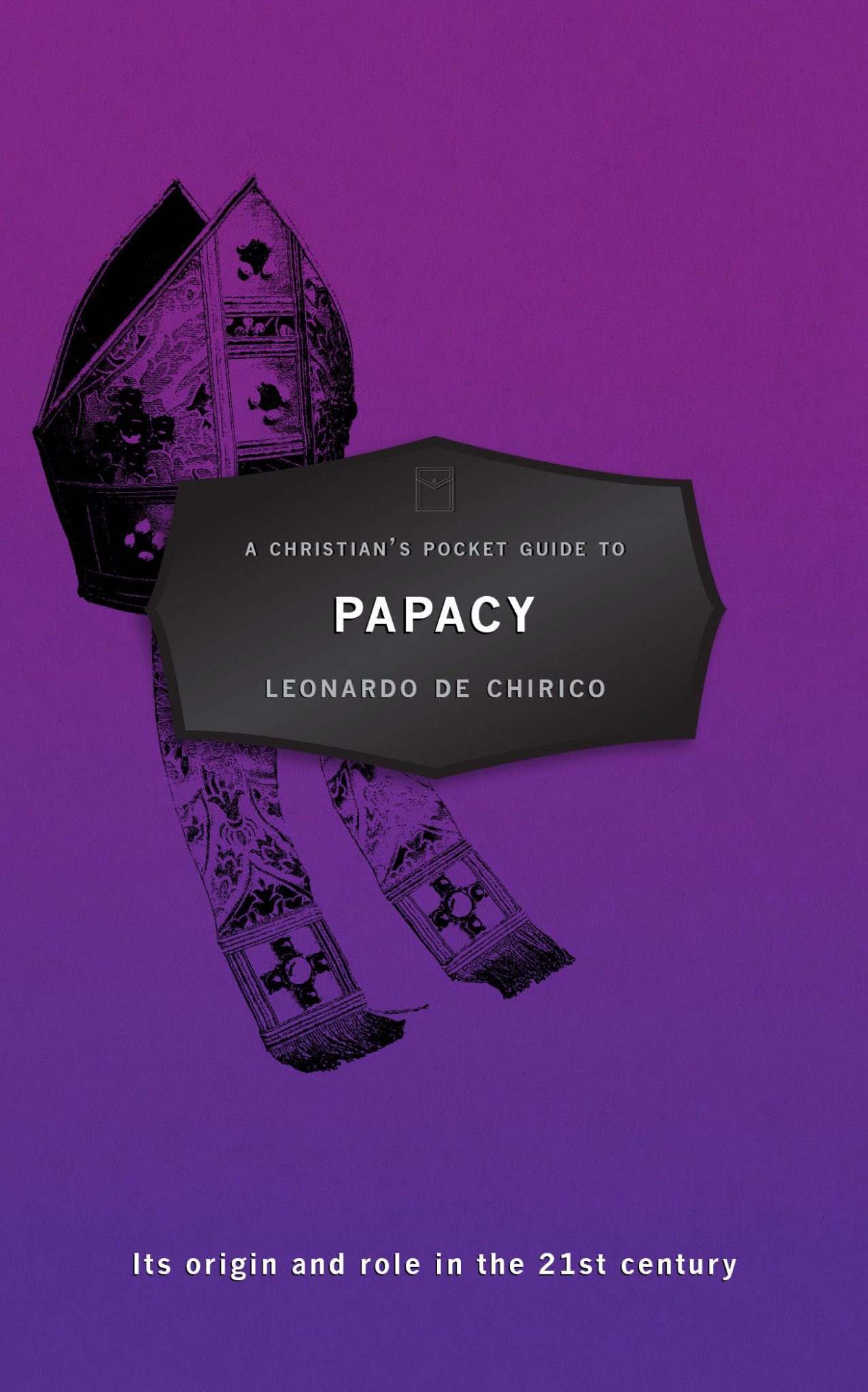The office of the papacy is an enigma to most evangelical Protestants. The spectacle of medieval regalia, papal coronation, gem-studded tiara (several of which are displayed at the Vatican), red leather loafers, and the popemobile tend to provoke curiosity, skepticism, and bewilderment. Add to these visible symbols the pope’s claim to supremacy, monarchial titles (over the Vatican, of which he is a head of state), infallibility, and a standing army, and the portrait gets even more perplexing.
Cutting through the fog of mystery and confusion is Leonardo De Chirico’s new book, A Christian’s Pocket Guide to the Papacy: Its Origin and Role in the 21st Century. De Chirico is ideally suited to write this volume. An Italian historical theologian with specialization in Roman Catholic history and thought, he has spent numerous years teaching in the Eternal City. He sits at the table in ecumenical dialogue with Vatican scholars while simultaneously pastoring a Protestant congregation (which he planted in partnership with Redeemer Presbyterian Church’s City to City initiative). Consequently, we’re getting a treatment that is in some sense “insider,” intimately acquainted with the finer points of the Vatican, and at the same time thoroughly evangelical, rock-ribbed in its commitment to Scripture’s supreme authority.
Form and Substance
De Chirico begins by examining the historical development of the papal office through its titles and symbols. Readers are then escorted to the Sistine Chapel to observe cardinals in conclave (“from the Latin cum clave, “locked up with a key”). By the way, such parenthetical definitions fill each chapter, providing insight into a myriad of Latin expressions (e.g., Pontifex Maximus, plenitude potestatis, ex-cathedra). A couple of paragraphs later, he consults the Catechism of the Catholic Church to note how such formulations are explicitly defined by contemporary Roman Catholic teaching. Whether it’s the “keys” of Peter, the pope’s throne, or his pallium (a woolen cloak), De Chirico explains how such symbols convey the form and substance of papal authority.

A Christian’s Pocket Guide to the Papacy: Its Origin and Role in the 21st Century
Leonardo De Chirico
A Christian’s Pocket Guide to the Papacy: Its Origin and Role in the 21st Century
Leonardo De Chirico
It’s not long before De Chirico asks the crucial question: “to what extent can the papacy as an institution be traced back to the Bible?” (14). A careful examination of Scripture reveals that despite the central role of Peter among the apostles, he wasn’t the “hero” later tradition made him out to be (15–16). Focused attention is given to key passages, such as Matthew 16, John 21:15–23 (where Jesus tells Peter, “Feed my sheep,”), and 1 Peter. De Chirico concludes, “[The doctrine of the papacy] cannot be found in Scripture in the way it is articulated in the Roman Catholic tradition” (26).
Given the expansive scope and density of Roman Catholic history, and relative complexity of her doctrinal formulations, De Chirico offers marginal symbols throughout his text that correspond to brief paragraph-long explanations, alerting readers to one of four particular lessons. These are labeled “Warning,” “Don’t Forget,” “Stop and Think,” and “Point of Interest.” Such statements provide a host of insights, which further elucidate the broader history, rationale, and thought-world in which the papacy has taken shape and currently exists.
Provocative Question
After a superb chapter on the historical development of the papacy up to the Renaissance, surveying the key persons and events around which the papacy has developed, De Chirico turns his attention to Protestant assessments of the papacy by asking the provocative question: Is the pope the antichrist? The positions of Luther and Calvin are taken up in turn, followed by the 17th-century Reformed scholastic theologian Francis Turretin, who contended the antichrist is represented by the papal office (58). From such arguments, De Chirico wishes to demonstrate that the notion of pope as antichrist does “not stem from slandering invectives of bandying insults.” Rather, the views were born out of a “highly sophisticated biblical and theological argument and were not driven by resentment alone” (58). The implicit question then naturally raised—what about the papacy today?—is precisely where De Chirico goes in the balance of his book.
The amount of historical detail De Chirico provides in the subsequent chapters is significant. Starting with Julius II (1503–1513) and his Fifth Lateran Council (1511–1517), he presents five centuries worth of papal highlights. Paul III’s Inquisition, Paul IV’s Index of Forbidden Books, the missionary initiatives of Gregory XV, Pius IV’s Syllabus of Errors, the dogma of Mary’s immaculate conception, Vatican I, Pastor Aeternus, (with its doctrine of infallibility), Leo XIII and his Rerum Novarum, Pius XII’s dogma of Mary’s assumption, and John XXIII’s aggiornamento are just a few examples. In what might easily degenerate into tedious cataloguing of events, De Chirico unfolds it all in a manner that is fresh and engaging.
The penultimate chapter of A Christian’s Pocket Guide to the Papacy concentrates on three of the most recent popes: John Paul II, Benedict XVI, and Francis. This is familiar territory for De Chirico, who maintains an online column on papal affairs called “Vatican Files.” He evaluates the major aims and achievements of each pontificate, the “unsettled” legacy of John Paul II, the meticulous orthodoxy of Benedict XVI, and inclusive impulse of Francis. These portraits provide the requisite background for his final chapter, which considers future prospects for the papacy.
Stumbling Block
Having surveyed the expanse of papal history, De Chirico concludes, “Nothing has changed since Trent and Vatican I. The Papacy is [considered by Catholics to be] a divinely given institution to be accepted as it stands” (95). Therefore, the papacy remains a stumbling block to ecumenical engagement (for both Eastern Orthodox and Protestant churches and movements, 99–100). One is left to assume that Turretin’s assessment of the papacy as antichrist is also true today, although this point isn’t made explicit.
My only disappointment with De Chirico’s book is the absence of a concluding section that recommends how evangelical Protestants should relate to the contemporary papacy. I suspect he has a lot to teach us in this area. For instance, I’d like to hear his reflection on whether (and how) Protestants should pray for the pontiff, especially given the prominence of the pope’s role as a spokesman for Christianity on the world stage. Why would we not ask God to stimulate gospel renewal in Francis’s heart, leading him to emphasize explicit faith in Christ in a manner that is biblically chaste? Then again, if one regards the pope as antichrist, then perhaps such prayers are inadvisable (for as Luther asserted, you don’t pray for antichrist). I suppose we’ll have to keep reading De Chirico’s Vatican Files to get his views on these issues.
De Chirico’s book is excellent. Not only is it well researched, thorough, and clear, its lessons hold crucial importance in this historical moment. In a day when the pope is featured on the cover of Time magazine and when unchurched pundits use phrases like “the Francis factor” (speaking of Pope Francis’s popularity in the mainstream), it’s important for us to have an informed perspective on the papacy. This volume, more than any other I’ve read, provides such perspective and therefore should be added to one’s bookshelf.


































